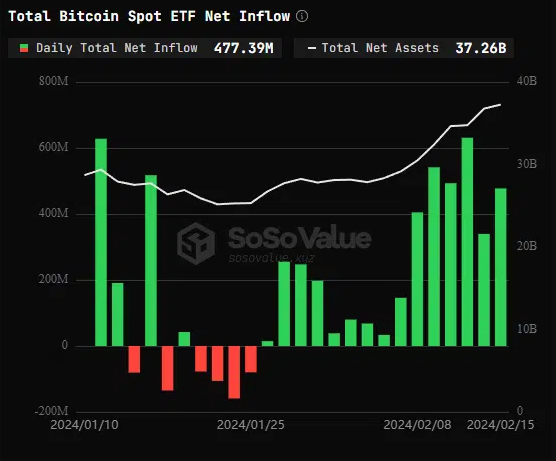- Bitcoin ETFs have seen a consistent increase in investment, with a total net inflow reaching $4.7 billion, signaling strong investor confidence in Bitcoin.
- While most Bitcoin ETFs experienced positive inflows, Grayscale’s GBTC faced significant outflows, shedding light on investor caution.
The cumulative net flow of the spot Bitcoin ETF market has steadily increased since it first emerged more than a month ago. February’s Bitcoin ETF inflows have picked up this week following a slow start. Over the past 15 trading days, these funds have seen a consistent influx of investments, culminating in a total net inflow of $477 million on February 15th, according to data from SOS value. The fact that the total net inflow for Bitcoin ETFs has reached an astounding $4.7 billion highlights investors’ growing confidence in Bitcoin as a viable investment instrument.
Notably, the $330 million daily net inflow into the BlackRock Bitcoin spot ETF, IBIT, propelled the fund to a cumulative historical net inflow of $5.17 billion. By comparison, the Grayscale ETF (GBTC) saw a $174 million net outflow on the same day, breaking from this trend.
The most significant single-day net inflow of $631.2 million occurred on February 13, when Bitcoin ETFs’ excitement was evident. The performance of other notable participants in the market, such as Fidelity’s FBTC, which has the third-highest daily trading volume and the second-largest net inflow at $3.65 billion, reflects this investor optimism.
The Grayscale Challenge and Future Outlook
Grayscale is facing difficulties, as seen by a sizable net outflow, notwithstanding the general upward trend. Grayscale’s GBTC has lost $6.856 billion since switching from a Trust to a Spot ETF, which may be because of greater fees than its rivals. This indicates investor nervousness. Nonetheless, the wider market for spot Bitcoin ETFs is still thriving; 692,939 bitcoins are held collectively, demonstrating strong market confidence in Bitcoin as an asset class.
Spot Bitcoin ETFs have made it much easier for regular investors to interact with Bitcoin by allowing them to use ordinary brokerage accounts for transactions. Because of its accessibility and minimal connection to other risk assets, Bitcoin is a desirable addition to investment portfolios that are diversified.BlackRock’s iShares Bitcoin Trust and Fidelity’s Wise Origin Bitcoin ETF have led the charge, amassing significant assets and reflecting the pent-up demand for Bitcoin exposure among investors.
With the exception of the Grayscale Bitcoin Trust, the market for Bitcoin ETFs has attracted over $10 billion in assets, indicating that the outlook is still positive. The expectation of a Bitcoin halving later this year, which is anticipated to further restrict supply amid increased demand through ETFs, supports this trend.
Analyzing the Shift in Investor Sentiment
In a CNBC interview, Michael Saylor, Executive Chairman of MicroStrategy, pointed out the uncorrelated nature of Bitcoin with traditional risk assets as a significant factor driving its adoption among investors. Given the reduced supply from miners, he highlighted the upcoming Bitcoin halving event as a potential catalyst for further increasing the demand for Bitcoin.
The market for gold ETFs has encountered difficulties, notwithstanding the enthusiasm around Bitcoin ETFs. A 2% reduction in the total assets under management for gold ETFs was announced by the World Gold Council. The loss was ascribed to a combination of macroeconomic causes and speculative positioning. Analysts are debating this comparison of the performance of gold ETFs and Bitcoin, with some advising against seeing this as a clear shift away from gold towards Bitcoin.
.
Source: https://www.crypto-news-flash.com/spot-bitcoin-etfs-garner-4-69-billion-in-net-flows-since-inception/?utm_source=rss&utm_medium=rss&utm_campaign=spot-bitcoin-etfs-garner-4-69-billion-in-net-flows-since-inception


